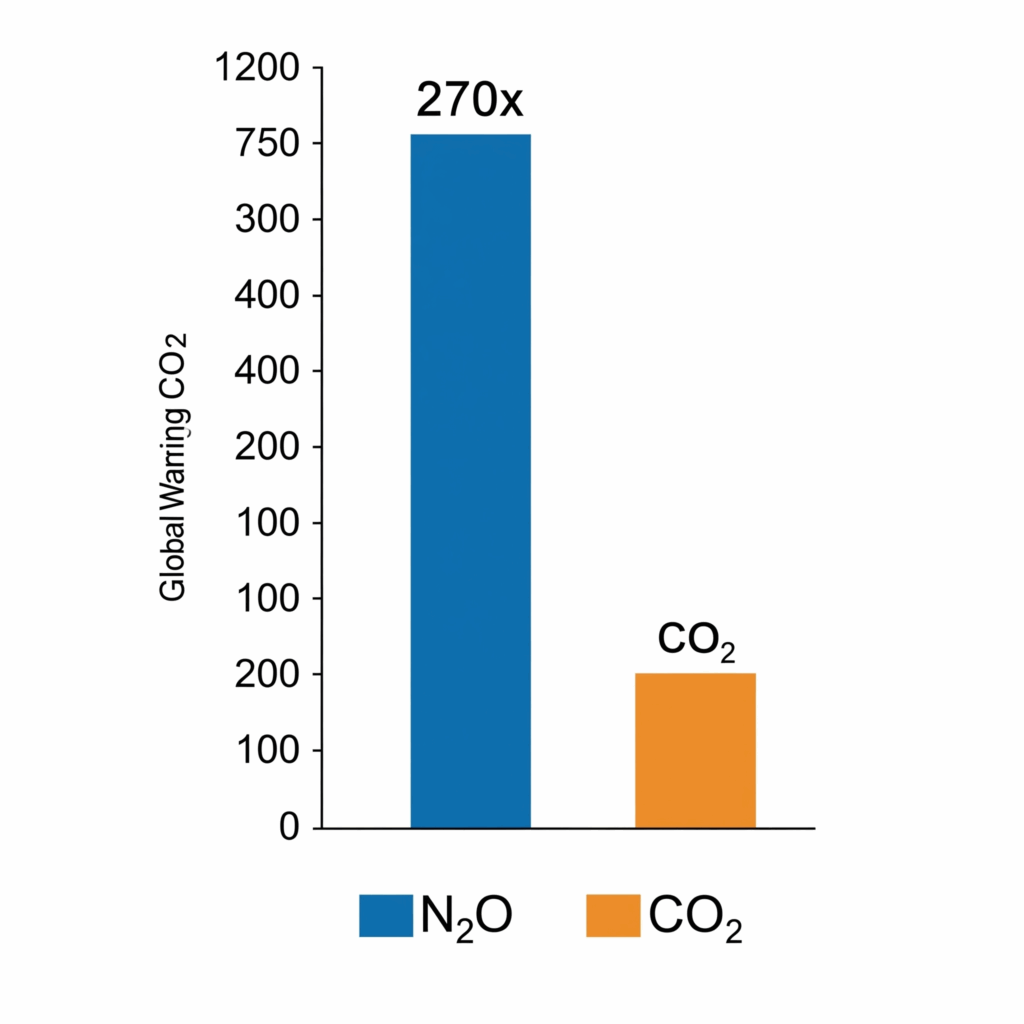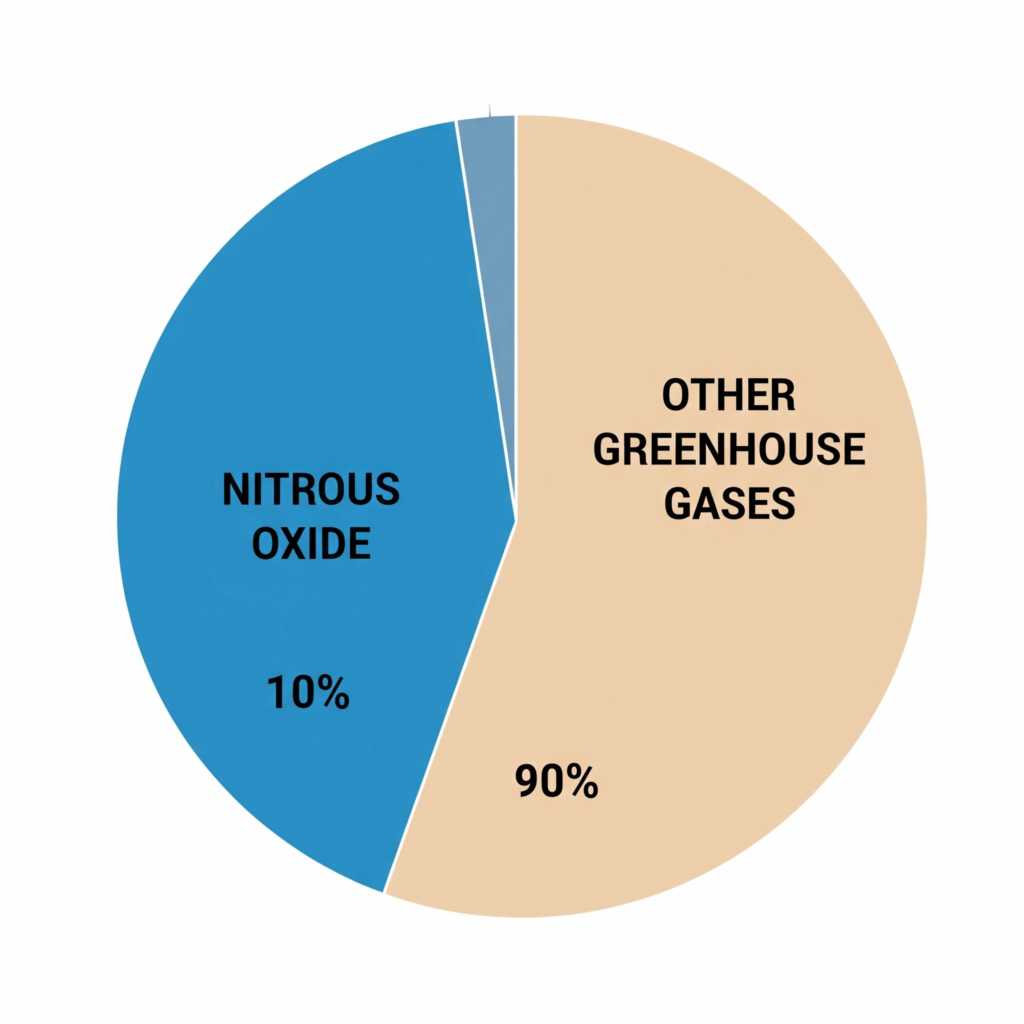A 3,000-word Deep Dive into the Climate, Health, and Hope
The Overlooked Greenhouse Gas
When we talk about climate change, carbon dioxide (CO₂) and methane (CH₄) dominate the conversation. Yet, nitrous oxide (N₂O)—commonly known as laughing gas—is quietly becoming one of the most dangerous greenhouse gases. With a global warming potential 270 times greater than CO₂, and a lifespan of over a century in the atmosphere, N₂O is a potent force accelerating global warming and depleting the ozone layer.
1. Understanding N₂O: Origins and Impact
Understanding nitrous oxide (N₂O) begins with recognizing its origins and the scale of its impact. The majority of N₂O emissions—over 70%—stem from agricultural activities, particularly the widespread use of synthetic fertilizers and the management of animal manure. These practices release nitrogen compounds into the soil, which are then converted by microbes into nitrous oxide. Beyond agriculture, industrial processes such as the production of nitric and adipic acid also contribute significantly to N₂O emissions. Additionally, the combustion of fossil fuels and biomass further adds to the atmospheric burden of this potent greenhouse gas.
What makes N₂O especially dangerous is its extraordinary potency and persistence. It is capable of trapping heat in the atmosphere 270 times more effectively than carbon dioxide (CO₂), making it a major driver of global warming despite its relatively lower concentration. Compounding this threat is its role in ozone layer depletion—N₂O is currently the most significant ozone-depleting substance still being emitted. Once released, it remains in the atmosphere for over a century, continuing to exert its harmful effects long after its initial emission. This combination of high global warming potential, ozone destruction, and atmospheric longevity makes N₂O a uniquely formidable challenge in the fight against climate change.
2. Visualizing the Crisis
To better understand the scale and urgency of the N₂O problem, the following charts illustrate its impact:
N₂O vs. CO₂ Warming Potential
This bar chart vividly compares the global warming potential of nitrous oxide (N₂O) to carbon dioxide (CO₂). The N₂O bar, labeled “270x,” towers over the CO₂ bar, highlighting that N₂O is 270 times more potent as a greenhouse gas over a 100-year period. This emphasizes the critical need to reduce N₂O emissions.
N₂O’s Contribution to Global Warming
This pie chart shows the percentage contribution of nitrous oxide to overall global warming. The slice labeled “Nitrous Oxide” represents 10% of the total, while the remaining 90% is grouped as “Other Greenhouse Gases.” This illustrates that while N₂O is far more potent than CO₂, it’s responsible for a significant, but smaller, portion of overall warming.
3. Human Health at Stake
Beyond climate, N₂O emissions are linked to air pollution through their interaction with ammonia and other compounds. This contributes to:
- Respiratory diseases
- Cardiovascular issues
- Premature deaths: Up to 20 million lives could be saved by 2050 through combined N₂O and ammonia reductions.
4. Solutions: What Can Be Done?
To effectively address the growing threat of nitrous oxide (N₂O) emissions, a multifaceted approach is essential. One of the most promising areas is agricultural innovation. Precision farming, which leverages data and artificial intelligence, allows farmers to optimize fertilizer use, thereby minimizing excess nitrogen that contributes to N₂O emissions. Additionally, the use of nitrification inhibitors—chemicals that slow the conversion of ammonium to nitrate—can significantly reduce emissions from soil. Transitioning to organic alternatives such as compost and biofertilizers also offers a sustainable way to replace synthetic nitrogen inputs.
Policy and regulation play a crucial role in driving systemic change. Integrating N₂O into global climate agreements, such as the Paris Agreement, would elevate its importance on the international stage. Reforming agricultural subsidies to favor sustainable practices over synthetic fertilizer use could shift industry behavior. Moreover, implementing N₂O-specific emission caps within emissions trading systems would create economic incentives for reduction.
Technological solutions are also advancing. Catalytic reduction technologies can be installed in industrial plants to neutralize N₂O emissions at the source. Emerging carbon capture technologies tailored for N₂O offer the potential to trap and safely store this potent gas before it reaches the atmosphere.
Finally, public awareness and education are vital. Consumers can make a difference by choosing sustainably grown food, thereby supporting environmentally responsible farming practices. Educational campaigns can help illuminate the hidden impact of N₂O, fostering a more informed and engaged public that supports climate-conscious policies and behaviors.
5. Hope for the Future
Despite the sobering statistics surrounding nitrous oxide and its impact on the planet, there remains a genuine sense of hope—provided we act swiftly and decisively. By implementing effective mitigation strategies, the world has the potential to avoid releasing up to 235 billion tonnes of CO₂-equivalent emissions by the year 2100. This would represent a monumental step toward stabilizing the climate and averting the most catastrophic consequences of global warming.
Moreover, reducing nitrous oxide and related pollutants could lead to significant improvements in air quality, potentially saving millions of lives from pollution-related illnesses by 2050. These health benefits would be felt globally, especially in regions currently burdened by poor air conditions. In addition to climate and health gains, curbing N₂O emissions would also help protect the ozone layer—our planet’s natural shield against harmful ultraviolet radiation—ensuring its continued recovery and safeguarding ecosystems and human health alike.
The encouraging reality is that the tools, technologies, and scientific understanding needed to tackle this issue already exist. What remains essential is the political will to enact bold policies, the global cooperation to implement them effectively, and the public engagement to support and sustain these efforts. With collective action, a safer, healthier, and more sustainable future is within reach.
A Call to Action
Nitrous oxide may be invisible and odorless, but its impact is anything but. As we strive to meet the climate goals of the 21st century, we must bring N₂O into the spotlight. The future of our planet—and our health—depends on it.
Related Content
- The world’s forgotten greenhouse gas
- What is Nitrous Oxide (N2O)?
- ChatGPT’s Carbon Footprint: Study Reveals AI Produces CO2 Equivalent to 260 Flights from NYC to London Monthly
- CO2-Eating Bacteria Turn Chimney Smoke Into Sustainable Fuel
- Lake Geneva’s Unexpected CO2 Emissions: Unraveling the Mystery
- The Largest CO2 Vacuum Cleaner in the World: Tackling Climate Change with Innovation
- Innovative CO2-free engine invented in France
- Lac du Bourget: A Sapphire Gem Forging a Path in Ecological Preservation and Sustainable Discovery
- Japan’s Kyosemi Corporation has unveiled a groundbreaking innovation in solar technology: Sphelar, the first photovoltaic spheres
- Breakthrough in Carbon Conversion: A Leap Toward Sustainable Fuel Production
- Rio Tinto Takes a Bold Step into the Future of Metals with E-Waste Recycling
- France’s Massive Natural Hydrogen Reserve: A Game Changer for Clean Energy and the Planet
- Biophotovoltaic Systems: The Next Evolution in Solar Energy
- Stanford Scientists Unveil a Faster, Cheaper Method to Lock Away Carbon Permanently
- Meet N2O, the greenhouse gas 300 times worse than CO2
- As heat records fall, experts call for reductions in this often-overlooked greenhouse gas



